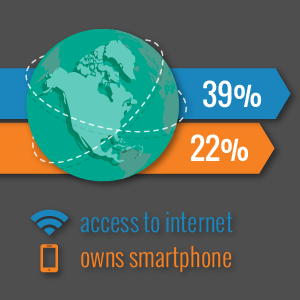In 2013 it is estimated that 255 babies were born every minute across the globe. Pretty amazing right?
Well this pales in comparison when we consider that more than 1,900 smartphones were shipped every minute in 2013. That’s smartphones, a device that allows the user to browse the web.
It goes without saying then that mobile should be a significant consideration for your business in the near future.
So the first step is to optimise your website for the mobile audience and whilst there’s some caveats in play here, we suggest you need to look at responsive web design.
What is responsive web design?
Responsive web design allows your website to respond and adapt to the size of the browser’s screen.It relies on a layout of flexible grids and a bit of magic with CSS, which is best described as using percentages over fixed widths.


In practical terms responsive web design allows your site to fit within the viewport of your audience’s device, delivering them a better user experience.
Why do I need a mobile-friendly website?
Because a mobile user experience is vastly different from a desktop user experience, and you don’t want to lose a potential customer because they can’t navigate your site from their phone or tablet.
OK so maybe some of you are quoting your site’s analytics and specifically a low percentage of visitors via mobile devices. That’s fair enough, you shouldn’t ignore the data. I just ask that you separate the desktop data and the mobile data and see how it affects their behavior – Look at time on site, pages per visit, bounce rate, and if you have goals set-up then look at them too.
If the data doesn’t show any discrepancies and you still don’t believe there is an issue for your business then you must have some doubts about mobile usage specific to your country, clientele or business.

Well, even the most developed countries are still yet to see significant smartphone penetration. The UAE leads the globe with 74% smartphone penetration, whilst Australia is not far behind at 65% and the United States further back at 56%.
This represents a long way to go and a lot of new smartphones to be shipped and a lot more mobile web browsers.
Our mobile browsing behaviours are also changing significantly. Google has said that before the end of 2014 it may see more search queries via mobile devices than desktop. In addition, global mobile data traffic grew 81% in 2013.
So even if you believe your business is not one to be browsed via mobile, can you ignore the trend?
+ Retaining visitors
It should go without saying that a better browsing experience will have a more positive effect on your audience than a poor browsing experience. So to retain visitors it makes sense to provide them with the best experience you can.
To highlight the situation, Google has published statistics referring to the impact of a mobile-friendly site on consumer behaviour:
- 67% of mobile users say that when they visit a mobile-friendly site, they’re more likely to buy a site’s product or service
- 48% said that if a site didn’t work well on their smartphones, it made them feel like the company didn’t care about their business
+ Better SEO
Google has a bias towards mobile. If your site is not providing a mobile-friendly experience you will be penalised either directly or indirectly. More specifically, Google is using user behavior within their algorithms to help rank your website. If a visitor lands on your website and they can’t navigate it to find what they want then they’ll leave, most likely to head back to the search results to find someone else. This is going to hurt.
Why do I need a responsive website?
It is just one approach but it is clearly the best approach for the majority of businesses.
+ Cost effective
The alternative to RWD is to design separate websites for desktop, mobile, and even perhaps tablet. As you can imagine the cumbersome approach costs money among other things.
+ Google recommends it
It’s a gutsy web developer or business who wants to ignore the recommendation of Google when the search environment plays such an integral role in business. Certainly, in Australia Google represents 92% of the search engine market – So it would be pretty silly to ignore.
+ Better SEO
A responsive website provides a single, unified approach that funnels all of the authority into the one domain. It makes it easier to build trust, acquire links, it’s more efficient for Google to crawl your site, and it’s easier for users to remember your page domains.
+ Future proof??
Who knew after the iPhone was released in 2007 that just three years later we would have the iPad launched to completely revolutionise our web experience (again).
Fast forward to 2014 and whilst we can still broadly categorise our mobile devices into tablets and mobiles, we have a variety of screen sizes that our websites must adapt to.
A responsive website will continue to respond and adapt to screens of all sizes, therefore we hope that it is somewhat (dare I say it) futureproof. Yes of course the emergence of wearables may completely flip this on its head within 10 years.
Check your user experience
One of the fastest ways of checking what your website looks like on the myriad of mobile devices is to use our responsive web design tool. Just insert your web url and scroll down to see how it behaves.
When responsive may not be suitable
Got a large site with mountain loads of data? Then responsive web design may not be your best choice. The alternative is to build a separate website with refined content tailored to your mobile visitor. You can then host the site at m.yoursite.com.au for example.
The mobile stats that will blow you away
+ Smartphone penetration
- Middle East and Asia dominates global smartphone penetration
UAE – 74%
Saudi Arabia & Korea – 73%
Singapore – 72%
Australia 65%
+ Mobile Traffic
- Last year’s mobile data traffic was nearly 18 times the size of the entire global Internet in 2000..
- Global mobile data traffic grew 81 percent in 2013.
+ Tablets
- In 2013, the number of mobile-connected tablets increased 2.2-fold to 92 million, and each tablet generated 2.6 times more traffic than the average smartphone
+ Projections
- By the end of 2014, the number of mobile-connected devices will exceed the number of people on earth, and by 2018 there will be nearly 1.4 mobile devices per capita.
- Global mobile data traffic will increase nearly 11-fold between 2013 and 2018.
Conclusion
You have to improve your website’s mobile browsing experience and for now that is responsive web design. It’s that simple. Your visitors will love the responsive experience and when your visitors love your experience you’re more likely to win new business and retain existing business. As far as your SEO efforts go, it’s becoming increasingly evident that if you keep your visitors happy then you’re keeping Google happy. It’s a no-brainer.
So take the next step right now and use this responsive test to see what your website looks like on some of the common mobile devices.
Every minute 1,900 smartphones are shipped, have you got a responsive website? is a post from:

